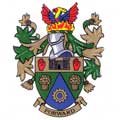Cookstown
| Cookstown | |
|---|---|
 Cookstown coat of arms |
|
| Cookstown shown within Northern Ireland | |
| Population | 10,646 (2001 Census) |
| Irish grid reference | H8178 |
| • Belfast | 45 miles |
| District | |
| County | |
| Country | Northern Ireland |
| Sovereign state | United Kingdom |
| Post town | COOKSTOWN |
| Postcode district | BT80 |
| Dialling code | 028 |
| Police | Northern Ireland |
| Fire | Northern Ireland |
| Ambulance | Northern Ireland |
| EU Parliament | Northern Ireland |
| UK Parliament | |
| NI Assembly | |
| Website | http://www.cookstown.gov.uk |
Cookstown is a town and townland in County Tyrone, Northern Ireland. It is the fourth largest town in the county and had a population of nearly 11,000 people in the 2001 Census. It is one of the main towns in the area of Mid-Ulster. It was founded around 1620 when the townlands in the area were leased by an English ecclesiastical lawyer, Dr. Alan Cooke, from the Archbishop of Armagh, who had been granted the lands after the Flight of the Earls during the Plantation of Ulster. It was one of the main centres of the linen industry West of the River Bann, and until 1956, the processes of flax spinning, weaving, bleaching and beetling were carried out in the town.
Cookstown's famous main street (laid out from c1735–c1800), is 1.25 miles (2.01 km) long and 135 feet (41.15 m) wide, one of the longest, and widest in Ireland.
The lands around the present site of Cookstown were, prior to the early 17th century, in the hands of the O'Mellan Clan and were broadly known as "Mellanagh". This land was confiscated by King James I after the Flight of the Earls of Tyrone and Tyrconnell in 1607 and a series of Rebellions in the area which saw the native landlords ousted from their holdings. The O'Mellan land was held to be the property of the Established (Anglican) Church and was thus presented to the Anglican Archbishop of Armagh who was charged with overseeing the settlement of the area with English and Scots "planters". In 1620, a small portion was leased by James Stewart (a Scots settler in the area) and lands around the townland of Cor Criche were leased to an English ecclesiastical lawyer, Dr. Cooke, who fulfilled the covenants entered in the lease by building 10 houses on the land (today covering the area known as Oldtown), which he stipulated were all to have front gardens (a tradition which still remains in place). In 1628, King Charles I granted Letters Patent to Cooke permitting the holding of a twice-weekly market for livestock and flaxen goods.
...
Wikipedia

